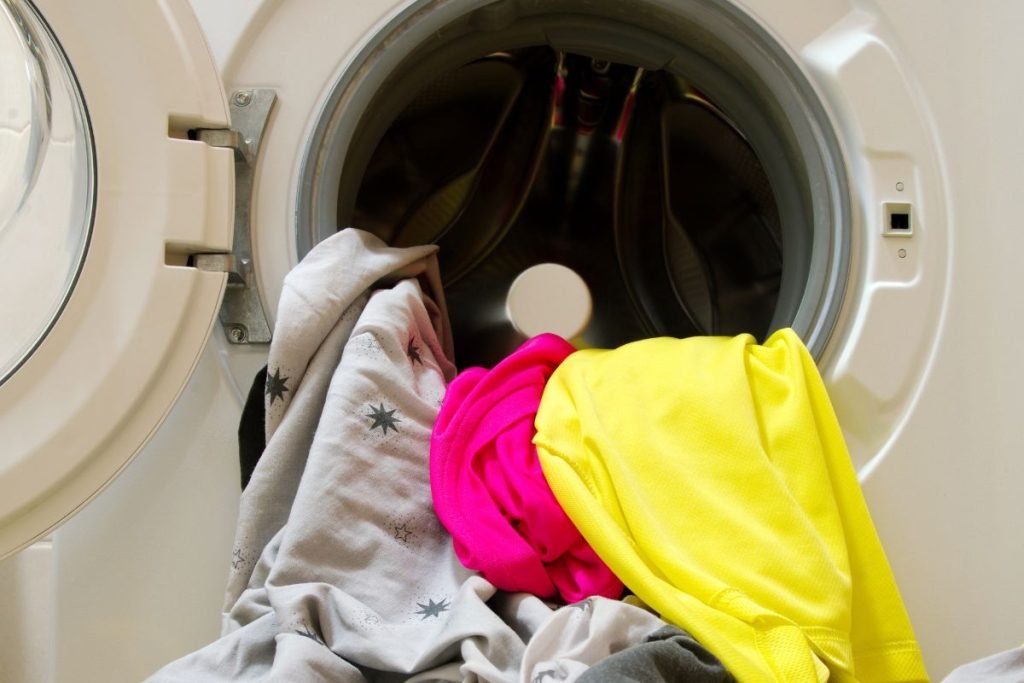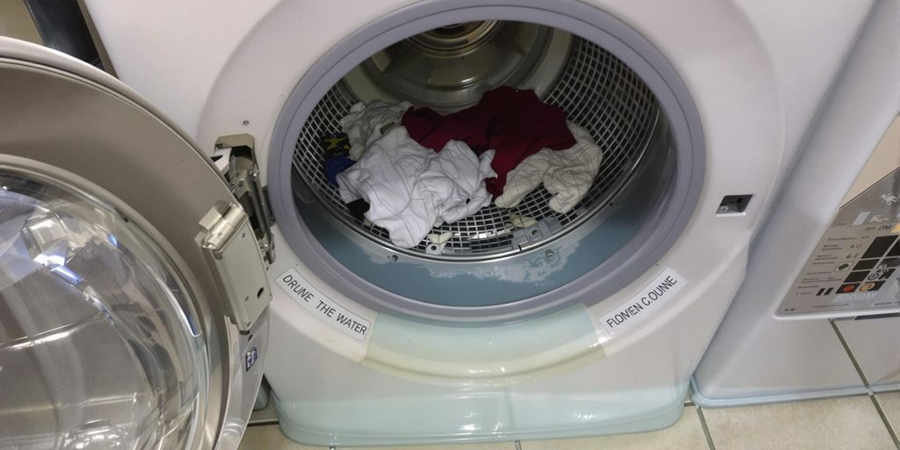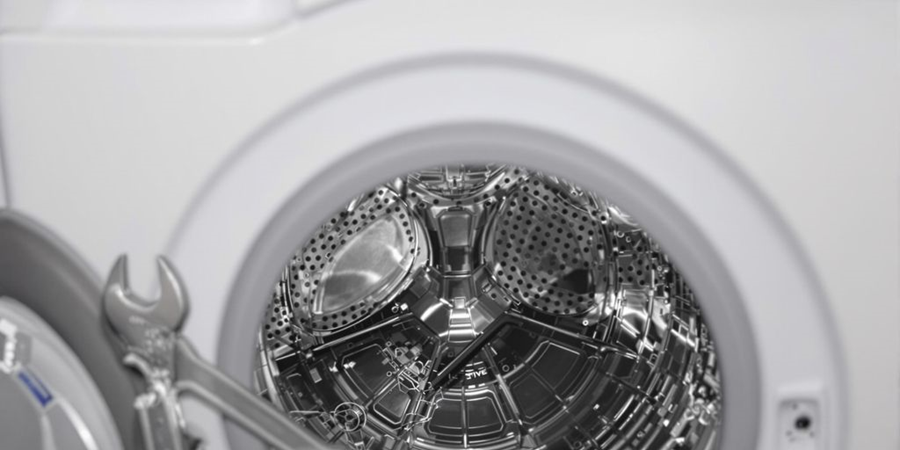
Ever started a laundry load, only to find your front load washer full of water? It’s frustrating, right? A washing machine that won’t drain can be a real headache, but don’t worry—it’s often something you can fix yourself. Let’s go over some common causes and simple solutions to get your washer back on track.
Key Takeaways
- A clogged drain pump filter is a common reason why your front load washing machine isn’t draining water.
- Blocked or kinked drain hoses can disrupt proper water flow and cause drainage problems.
- Unusual noises or leftover water after a spin cycle might mean a faulty drain pump.
- Regular maintenance like cleaning filters and avoiding overloading helps prevent drainage issues.
- If DIY fixes don’t work, persistent problems may need professional attention.
Common Reasons Your Front Load Washer Won’t Drain
Clogged Drain Pump Filter
One of the most frequent culprits is a clogged drain pump filter. This small but essential component traps debris like lint, coins, and other small objects, preventing them from damaging the washer. Over time, the filter can become blocked, stopping water from draining properly. Regular cleaning of the filter can save you a lot of trouble down the line.
Blocked Drain Hose
A blocked or kinked drain hose is another common issue. If water can’t flow freely through the hose, it will back up into the drum. Inspect the hose for bends, clogs, or damage. Sometimes, simply straightening the hose or removing a clog can solve the problem. If you’re dealing with persistent issues, check out our services for professional assistance and reliable solutions
Malfunctioning Drain Pump
The drain pump does the heavy lifting when it comes to pushing water out of the washer. If it’s not working correctly, water will stay in the drum. You might hear unusual noises or notice that the spin cycle isn’t completing. In this case, the pump might need repair or replacement.
Electrical Issues Affecting Drainage
Sometimes, the problem isn’t mechanical but electrical. Faulty wiring or a malfunctioning control board can prevent the washer from signaling the drain pump to do its job. Diagnosing electrical issues often requires professional help, especially if you’re unfamiliar with wiring or circuit boards.
If your washer isn’t draining, don’t panic. Start by checking for simple issues like blockages or kinks. These are often the easiest and cheapest fixes.
How to Check for Blockages in the Drain Hose
Locating the Drain Hose
The first step in solving drainage problems is finding the drain hose. It’s usually located at the back of your washing machine and connects to your home’s plumbing. Make sure the washer is unplugged before you start inspecting anything. Safety first! Once you’ve located the hose, take a good look to ensure it’s securely attached and not visibly damaged.
Inspecting for Kinks or Obstructions
Sometimes, the issue is as simple as a kinked hose. Straighten out any bends or folds you see. If that doesn’t fix the problem, you might need to check for blockages inside the hose. To do this, detach the hose carefully—be prepared for some water to spill out. A flashlight can help you spot any clogs like lint, detergent residue, or small objects.
Steps to Clear a Blocked Hose
- Disconnect the hose from both the washing machine and the wall drain.
- Use a long, flexible cleaning brush to reach inside and remove any debris.
- Run water through the hose to confirm it’s clear.
- Reattach the hose securely and run a test cycle to see if the problem is resolved.
A blocked drain hose can lead to standing water in the washer drum, making it essential to address the issue promptly. Ignoring it might result in more serious problems down the line, like a damaged drain pump or even water leakage.
If you hear gurgling or bubbling noises during drainage, it could be a sign of a partially blocked hose. Proper maintenance and timely unclogging can keep your washer running smoothly. For more tips on dealing with standing water in the washer drum, regular inspections are key.
Signs of a Faulty Drain Pump in Your Washing Machine
Unusual Noises During Drain Cycle
If your washing machine starts making strange sounds during the drain cycle, it could be a sign of trouble with the drain pump. You might hear grinding, rattling, or buzzing noises that weren’t there before. These sounds often happen because debris like coins, buttons, or small objects have gotten stuck in the pump. Over time, this can damage the pump’s internal parts and make it less effective.
Water Remaining After Spin Cycle
Water left behind in the drum after the spin cycle is a big red flag. Normally, the drain pump should remove all the water, leaving your clothes just damp enough for drying. If you notice puddles or standing water, the pump might not be working as it should. Sometimes, this happens because the pump is clogged, but it could also mean the pump motor isn’t functioning anymore.
How to Test the Drain Pump
Testing the drain pump isn’t as complicated as it sounds, but it does take some effort. Here’s a quick rundown of how to do it:
- Unplug the washer to avoid any electrical accidents.
- Locate the drain pump—usually near the bottom of the machine.
- Disconnect the hoses attached to the pump and inspect for blockages.
- Use a multimeter to check the pump’s motor for continuity. If there’s no reading, the motor is likely faulty.
A faulty drain pump can sneak up on you, causing minor annoyances at first but leading to bigger problems if ignored. Acting quickly can save you from costly repairs later on. If your washer is making unusual noises, addressing the issue early can prevent further damage. For expert assistance, check out Laundry Appliances Repair Services to keep your machine running smoothly
Preventing Drainage Problems in Front Load Washers

Regular Cleaning of the Drain Pump Filter
The drain pump filter is like a catch-all for lint, small objects, and other debris that can block water flow. Cleaning this filter regularly can help avoid drainage issues down the line. A good rule of thumb is to clean it every three months or more often if you do a lot of laundry. Neglecting it can lead to water buildup and, eventually, a washer that won’t drain properly.
Avoiding Overloading the Washer
Overloading your washer might seem like a time-saver, but it’s actually a recipe for trouble. When the drum is too full, water and detergent can’t circulate properly, which can strain the drain pump and lead to clogs. Stick to the manufacturer’s recommended load size, and if you’re unsure, err on the side of smaller loads. Your washer—and your clothes—will thank you.
Using the Right Detergent for Front Load Machines
Not all detergents are created equal. For front load washers, you need to use a high-efficiency (HE) detergent. Regular detergents can create too many suds, which may interfere with the washer’s ability to drain properly. Always check the label on your detergent to ensure it’s HE-compatible. Too many suds can also leave a residue that builds up over time, leading to blockages.
A little maintenance goes a long way in keeping your washer running smoothly. Take the time to clean filters, use the right detergent, and avoid overloading—it’s worth it to prevent bigger headaches later on.
For an extra tip, make sure there’s an air gap between the drain hose and the drain pipe. This small step helps break suction and allows proper drainage, reducing the risk of water backing up into your machine.
“If your front load washing machine is still not draining properly, Call us! Our experts are ready to assist you with troubleshooting and repairs to get your appliance back in working order.”
DIY Fixes for a Washing Machine That Won’t Drain

Draining Water Manually
If your washer is filled with water and won’t drain, you can start by removing the water manually. This is often the first step before attempting any repairs. Here’s how you can do it:
- Unplug the washing machine to ensure safety.
- Locate the drain pump filter, usually at the bottom front of the washer.
- Place a shallow pan or bowl under the filter to catch the water.
- Slowly unscrew the filter cap to let the water drain out—be prepared, it might get messy!
- Once the water is out, clean the filter thoroughly to remove any debris or lint.
This process might take a little time, but it’s a necessary step to access other components for troubleshooting.
Cleaning the Drain Pump Filter
The drain pump filter is a common culprit when your washer won’t drain. Over time, it can get clogged with lint, hair, or even small objects like coins. Here’s what to do:
- Open the access panel (usually at the bottom of the washer).
- Unscrew the filter cap and remove it.
- Clean out any debris or buildup inside the filter.
- Rinse the filter under running water to ensure it’s completely clear.
- Reinstall the filter and close the panel securely.
Tip: Regularly cleaning the drain pump filter can prevent future drainage problems.
Resetting the Washer to Clear Errors
Sometimes, your washer might just need a quick reset to clear any error codes or glitches. Follow these steps:
- Turn off the washer and unplug it from the power source.
- Wait for about 5-10 minutes to allow the system to reset.
- Plug the washer back in and turn it on.
- Select a drain or spin cycle to see if the issue is resolved.
Resetting the washer is a simple but effective solution that can save you from unnecessary repairs. It’s always worth trying before calling for help.
By following these DIY fixes, you might just get your washing machine back to working order without spending a dime on professional help. Just take it step by step, and don’t rush the process.
When to Call a Professional for Washer Drainage Issues
Persistent Drainage Problems
If your washer constantly struggles to drain, even after you’ve tried basic fixes like clearing the drain pump filter or checking the hose, it might be time to bring in an expert. Repeated issues often point to a deeper mechanical problem that requires professional tools or expertise to diagnose and repair. Don’t let it drag on—prolonged drainage problems can lead to more damage over time.
Signs of Electrical Malfunctions
Sometimes, the issue isn’t mechanical but electrical. If your washer won’t drain and you notice flickering lights on the control panel, strange error codes, or even a complete loss of power during the drain cycle, an electrical fault could be the culprit. Electrical issues can be tricky—and dangerous—to handle on your own, so it’s best to leave these to a trained technician.
Cost vs. Benefit of Repairs
Before calling a pro, consider whether repairing your washer is worth it. Here’s a quick way to weigh your options:
| Situation | Suggestion |
| Washer is under warranty | Go ahead and call a professional; it may cost you nothing. |
| Washer is over 5-7 years old | Weigh the cost of repair vs. replacing the machine. |
| Repair estimate is over 50% of the washer’s value | Think about upgrading to a new model. |
When in doubt, a professional can help you figure out whether it’s worth fixing or replacing your washer. Sometimes, spending a little now can save you a lot later.
If you’re unsure about the problem or feel overwhelmed, don’t hesitate to get help. A professional can save you time, stress, and possibly money in the long run.
“If you’re still experiencing drainage issues with your front load washing machine, feel free to contact us for expert assistance and support.”
Understanding the Role of the Drain Pump Filter
What the Drain Pump Filter Does
The drain pump filter in your front load washer plays a key role in keeping the machine running smoothly. Its main job is to trap debris like lint, coins, and small objects that might otherwise clog the drain pump or hose. Without it, these items could cause serious blockages or even damage the pump itself. Think of it as the washer’s first line of defense against drainage problems.
How to Access and Clean the Filter
Cleaning the drain pump filter isn’t as daunting as it sounds. Here’s a quick guide to help you out:
- Locate the filter access panel, usually at the bottom front of the washer.
- Place a shallow pan or towel underneath to catch any water that spills out.
- Turn the filter cap counterclockwise to remove it.
- Pull out any debris or buildup inside the filter.
- Rinse the filter under running water and put it back in place.
Doing this every few months can save you from bigger headaches down the road.
Common Issues with Dirty Filters
When the drain pump filter gets clogged, your washer might show some clear signs:
- Water pooling in the drum after the cycle ends.
- Longer-than-normal drainage times.
- Error codes flashing on the machine’s display.
If you notice these issues, checking the filter should be your first step. A dirty filter can make your washer work harder than it needs to, which might lead to wear and tear over time.
Regular maintenance of your washer’s drain pump filter can help prevent drainage problems and keep your machine running efficiently. It’s a small task that makes a big difference.
Wrapping It Up
So, there you have it. If your front load washing machine isn’t draining, it could be something as simple as a clogged filter or as tricky as a faulty pump. The key is to take it step by step—check the basics first before jumping to bigger fixes. And hey, if you’re not comfortable poking around inside your machine, there’s no shame in calling a pro. Sometimes, it’s just easier to let someone else handle the mess. Hopefully, these tips help you get your washer back in action without too much hassle. Good luck!
Frequently Asked Questions
Why is my front load washer not draining water?
Your washer might not be draining because of a clogged filter, a blocked drain hose, or a faulty drain pump. Electrical issues could also be the cause.
How do I check if my drain hose is blocked?
First, locate the drain hose at the back of the washer. Look for kinks or clogs, and clear them out using a long brush or by rinsing the hose.
What are the signs of a broken drain pump?
If you hear strange noises during the drain cycle or notice water left in the drum after spinning, the drain pump might be the issue.
Can I fix drainage problems myself?
Yes, you can try cleaning the drain pump filter, clearing blockages in the hose, or manually draining the washer. If these don’t work, you might need professional help.
How often should I clean the drain pump filter?
It’s a good idea to clean the filter every few months to prevent clogs and keep your washer running smoothly.
When should I call a professional for drainage problems?
If you’ve tried basic fixes and the problem persists, or if you suspect electrical issues, it’s best to call a professional.
“Still struggling with a washing machine that won’t drain? Call us today for expert assistance and quick solutions to get your appliance running smoothly again!”
